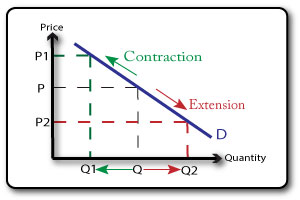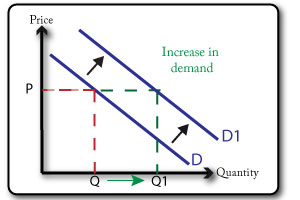Movement along the Curve v/s Shift of Curves
If we consider changes in price of a commodity as the only factor influencing its
quantity demanded, then we experience movements on the same curve. We either
have extension or contraction of demand.
When factors other than price of the commodity influence demand for that commodity, then we have either increase or decrease in demand shown by complete shifts in the demand curve.
When at the same price more is demanded or at higher price same quantity is demanded then there is increase in demand due to other factors.
Conversely at the same price of a commodity if less of its quantity is demanded or when at a lower price same quantity is demanded then there is a decrease in demand. (See the chart above).
In short, extension and contraction of demand are shown by movement along the demand curve, whereas increase or decrease in demand will be shown by shifts in the curve.
When factors other than price of the commodity influence demand for that commodity, then we have either increase or decrease in demand shown by complete shifts in the demand curve.
When at the same price more is demanded or at higher price same quantity is demanded then there is increase in demand due to other factors.
Conversely at the same price of a commodity if less of its quantity is demanded or when at a lower price same quantity is demanded then there is a decrease in demand. (See the chart above).
In short, extension and contraction of demand are shown by movement along the demand curve, whereas increase or decrease in demand will be shown by shifts in the curve.
Demand Analysis
Demand for Durable & Non-Durable goods
Non-durable lose their utility in a very short period hence demand for them depends upon prevailing conditions such as style, income or convenience.
Durable goods are demanded for future use; hence expectations play a vital role in influencing demand for them. Storability and postponability are two peculiar characteristics of durables.
Long-run and Short-run demand
Short run demand refers to the demand that exists at a point of time. It has immediate reaction to change in price and income.
Long run demand refers to the demand that will ultimately exist over a period of time as a result of price changes, competition, product improvement etc.
Direct Demand (Autonomous Demand) and Derived Demand
Demand is direct when it is to satisfy a human want. It is also called Pure Demand or Conventional Demand. Derived Demand, on the other hand, is to satisfy some other requirement. Thus cement is required for buildings and construction, so its demand depends upon that for buildings. Or demand for petrol depends upon vehicles.
Demand for Durable & Non-Durable goods
Non-durable lose their utility in a very short period hence demand for them depends upon prevailing conditions such as style, income or convenience.
Durable goods are demanded for future use; hence expectations play a vital role in influencing demand for them. Storability and postponability are two peculiar characteristics of durables.
Long-run and Short-run demand
Short run demand refers to the demand that exists at a point of time. It has immediate reaction to change in price and income.
Long run demand refers to the demand that will ultimately exist over a period of time as a result of price changes, competition, product improvement etc.
Direct Demand (Autonomous Demand) and Derived Demand
Demand is direct when it is to satisfy a human want. It is also called Pure Demand or Conventional Demand. Derived Demand, on the other hand, is to satisfy some other requirement. Thus cement is required for buildings and construction, so its demand depends upon that for buildings. Or demand for petrol depends upon vehicles.
Joint or Complementary Demand
Some goods are demanded in a combination. Tea and sugar or tyres & tubes are examples. Thus demand for complementary is a joint demand.
Cross Demand
Demand for substitutes takes the form of cross demand.
Composite Demand
Composite demand implies that a commodity under consideration can be put to several uses. Demand for electricity is a composite demand as it can be used or lighting, cooing or ironing.
Industry Demand and Firm Demand
Demand for products of a particular company is called Firm Demand. Industry demand is demand for products produced by all companies in the Industry. Thus demand for coffee is Industry demand while demand for Nescafe, coffee produced by Nestle’, is Firm demand.
Under monopoly both these demands will be identical. While in perfect competition these two will be very different.
Total Market Demand and Market Segments Demand
Overall demand for a product in the market is Total Market Demand. That for products in the North India, or from upper middle class, or through mail order is Market Segments Demand.
Some goods are demanded in a combination. Tea and sugar or tyres & tubes are examples. Thus demand for complementary is a joint demand.
Cross Demand
Demand for substitutes takes the form of cross demand.
Composite Demand
Composite demand implies that a commodity under consideration can be put to several uses. Demand for electricity is a composite demand as it can be used or lighting, cooing or ironing.
Industry Demand and Firm Demand
Demand for products of a particular company is called Firm Demand. Industry demand is demand for products produced by all companies in the Industry. Thus demand for coffee is Industry demand while demand for Nescafe, coffee produced by Nestle’, is Firm demand.
Under monopoly both these demands will be identical. While in perfect competition these two will be very different.
Total Market Demand and Market Segments Demand
Overall demand for a product in the market is Total Market Demand. That for products in the North India, or from upper middle class, or through mail order is Market Segments Demand.


No comments:
Post a Comment